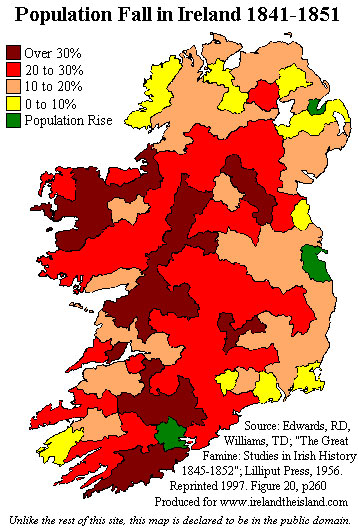
Ireland is a small island country in Europe, but this small country has made an enormous impact on the United States. Click on the link below to learn a little more about the Emerald Isle.
In this section, you will examine an event that occurred in Ireland and led to massive migration to the United States. Take a look at this animation to gain a little background.

Potatoes were the primary food source in Ireland during the 1800s. A fungus destroyed the potato crops and created a devastating famine. Starvation plagued Ireland and within five years, a million Irish were dead while half a million had arrived in America to start a new life. Living conditions in Ireland were deplorable long before the Potato Famine of 1845, however, and a large number of Irish left their homeland as early as the 1820s.

The Irish Potato Famine is often credited with launching the second wave of Irish immigration to America. In fact, Ireland's population decreased dramatically throughout the nineteenth century. Census figures show an Irish population of 8.2 million in 1841, 6.6 million a decade later, and only 4.7 million in 1891.
![]() Find Ireland on the map below and click on it to determine where the Irish migrated in response to the famine.
Find Ireland on the map below and click on it to determine where the Irish migrated in response to the famine.
It is estimated that as many as 4.5 million Irish arrived in America between 1820 and 1930. Many of the Irish also migrated to Great Britain, Canada, and Australia.
Between 1820 and 1860, the Irish constituted over one third of all immigrants to the United States. In the 1840s, they comprised nearly half of all immigrants to this nation. Interestingly, pre-famine immigrants from Ireland were predominately male, while in the famine years and their aftermath, entire families left the country. In later years, the majority of Irish immigrants were women.
You will now analyze how the Irish migration (and immigration) to the United States changed over time. Use the interactive Immigration Explorer map to answer the questions that follow in your notes. Read the directions carefully.